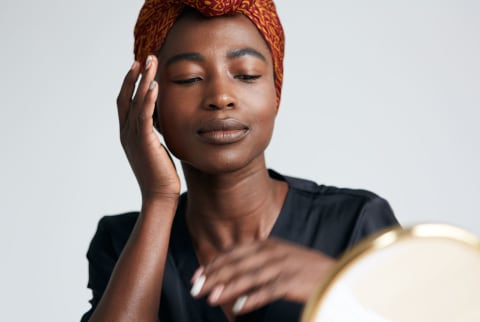The One Underrated Ingredient A Cosmetic Chemist Swears By For Stressed-Out Skin
Fellow ingredient buffs, read on.

Advertisement
This ad is displayed using third party content and we do not control its accessibility features.
Advertisement
This ad is displayed using third party content and we do not control its accessibility features.

Former Senior Beauty & Lifestyle Editor
Former Senior Beauty & Lifestyle Editor
Jamie Schneider is the former Senior Beauty Editor at mindbodygreen. She has a B.A. in Organizational Studies and English from the University of Michigan, and her work has appeared in Coveteur, The Chill Times, and Wyld Skincare.
Image by ohlamour studio / Stocksy June 17, 2025 We carefully vet all products and services featured on mindbodygreen using our Our selections are never influenced by the commissions earned from our links. As a self-proclaimed ingredient nerd, I'm always happy to chat about the science behind my favorite skin care formulas. There's just something so satisfying about understanding the chemistry involved—how those ingredients work in tandem to soothe, exfoliate, or brighten the skin—and discovering what makes a product truly sing. Clean cosmetic chemist Krupa Koestline filled me in on one of her favorite underrated players for stressed-out skin—suffice it to say I drank up the info and did some digging. Her go-to skin soother is a botanical called blue tansy, and it's top-notch for an angry, inflamed complexion. Fellow ingredient buffs, read on. 
What is blue tansy?
Blue tansy (also called blue chamomile) comes from the Tanacetum Annuum plant native to Morocco—which, contrary to what you might think, isn't actually blue: Rather, the plant is yellow with button-like flower heads. It's when the essential oil gets extracted from the leaves and distilled that it transforms into a deep indigo hue, and it's this oil that's commonly used in skin care.
Think of blue tansy as the jewel-toned cousin of chamomile: Both have anti-inflammatory benefits for the skin (which we'll discuss in a jiff), but in slightly different ways. "They are from a completely different genus of plants and smell very different, with different properties, too," says Koestline. (Blue tansy smells fruitier than your average chamomile.)
Benefits for skin
"Because of its anti-inflammatory properties and antioxidant potential, it is a great oil for sunburned, sun-damaged, inflamed, or stressed skin," Koestline continues. A worthy grab for summer, it seems.
A few main components are key for blue tansy's ticket to fame: chamazulene, camphor, sabinene, and sesquiterpene lactones. Let's dig into the science:
How to incorporate it into your routine
Yes, blue tansy has some anti-inflammatory properties, but it's still a powerful essential oil—so you should never apply it directly to your skin. You can mix a few drops into your moisturizer or face oil before slathering on, but make sure there's some sort of carrier there to dilute the potency. You may even want to do a patch test on your arm first, just to make sure you don't face any irritation from the oil.
As for when to incorporate this calming oil into your regimen, Koestline prefers to use it before bed. "I love blue tansy in my night routine," she says, not only for its ability to cushion the skin while you snooze but also for the "soothing and calming scent that promotes restful sleep."
The takeaway
Ingredients to calm inflamed skin range far and wide—Koestline's favorite just happens to be blue tansy. If you've never dabbled with the oil before, please do perform a patch test before applying it all over your face (we repeat: It's a potent EO, which can be irritating on sensitive skin). Other than that, it's a promising skin soother.
Advertisement
This ad is displayed using third party content and we do not control its accessibility features.

 ValVades
ValVades 































